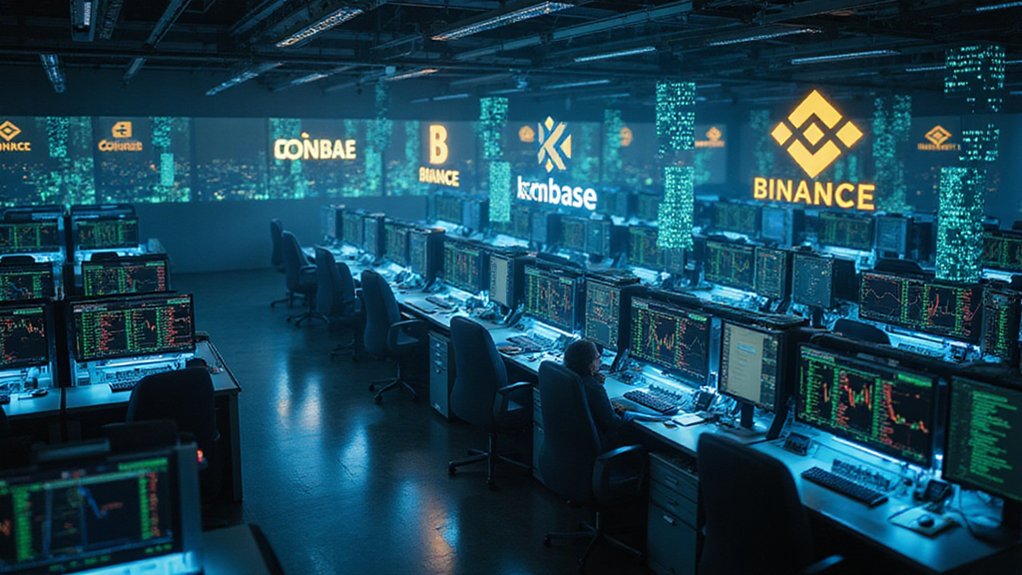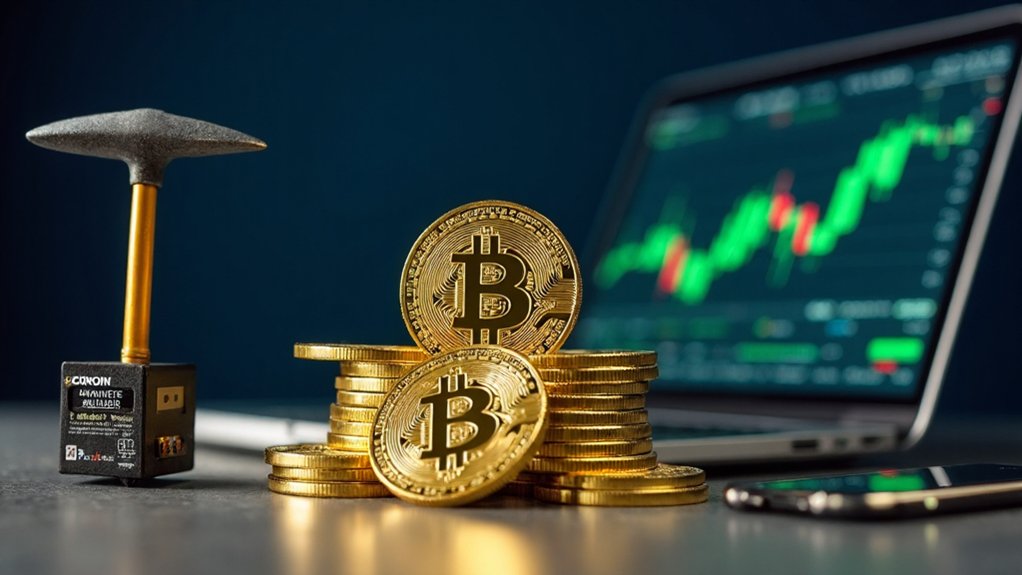Binance dominates the crypto exchange landscape with the majority of global trading volume, followed by Coinbase Pro, Huobi, and Kraken. While international platforms thrive, US-based exchanges operate under stricter regulatory frameworks—Coinbase offers 235 cryptocurrencies, Kraken supports over 350, and Binance US lists just 158. Fee structures vary considerably; Coinbase charges up to 3.99%, Kraken caps at 0.4%, and Binance US extends to 0.6%. The complete exchange ecosystem reveals fascinating competitive dynamics beneath the surface.

The vast ecosystem of cryptocurrency exchanges has evolved into a multi-trillion-dollar battleground where a handful of dominant players now control the majority of global trading volume.
The crypto exchange landscape: a trillion-dollar arena ruled by digital leviathans reshaping global financial markets.
Binance consistently reigns supreme in this digital coliseum, with Coinbase Pro, Huobi, Kraken, Bithumb, and Bitfinex following in its formidable wake.
These titans facilitate the daily churning of billions in digital assets, their orderbooks representing the contemporary pulse of crypto finance.
Within the United States’ regulatory framework, a more circumscribed roster of exchanges competes for market share.
Coinbase offers approximately 235 cryptocurrencies with a fee structure ranging from 0% to an eyebrow-raising 3.99%—a premium many users inexplicably continue to pay.
Kraken presents a more economical alternative with fees capped at 0.4% while providing access to over 350 digital assets.
Binance’s American subsidiary, hamstrung by regulatory constraints, lists a more modest 158 cryptocurrencies with fees extending to 0.6%.
The diversity of available cryptocurrencies has become a significant competitive differentiator.
Bitmart stands as the veritable Alexandrian library of crypto with over 1,700 tokens (caveat emptor¹), while Kraken and Crypto.com both support more than 300 cryptocurrencies.
Payment accessibility varies considerably across platforms—Coinbase and Kraken offer the most extensive options, including the PayPal integration that retail investors increasingly demand.
Savvy traders can reduce costs by utilizing Coinbase Advanced Trade, where the maker-taker model offers significantly lower fees than Coinbase’s standard platform.
Recent market data reveals fascinating shifts in the centralized exchange landscape.
The first quarter of 2025 witnessed a 16.3% decline in trading volume across the top ten exchanges, suggesting either market consolidation or capital migration to decentralized alternatives.
Indeed, DEX activity presents its own narrative, with Solana briefly achieving dominance during January’s meme coin frenzy before Ethereum reasserted its primacy in March.
This oscillation between chains underscores the fluid nature of cryptocurrency markets, where today’s kingmaker can become tomorrow’s afterthought with remarkable velocity.
For newcomers to cryptocurrency trading, Coinbase is best for beginners with its powerful trading tools and basic-to-advanced order types that ease the learning curve.
Crypto.com has emerged as a notable competitor with its over 350 cryptocurrencies supported and extensive fiat currency options for traders seeking diverse portfolio opportunities.
¹The prudent investor might question the quality assessment procedures for such an extensive token selection.
Frequently Asked Questions
How Are Crypto Exchange Fees Calculated?
Crypto exchange fees operate on a multi-tiered calculus, typically assessed as percentage-based commissions (0.1%-0.5%) on transaction value.
These fees follow maker-taker models—where limit orders command lower rates than market orders—and decrease proportionally with 30-day trading volume.
The complete fee structure encompasses not merely trading costs but withdrawal charges (varying by asset and network congestion), occasional deposit fees, and potential maintenance penalties—all contributing to the total transaction overhead.
What Security Measures Should I Look for in Exchanges?
Prudent investors scrutinize exchanges for multi-layered security infrastructure: robust MFA protocols, cold storage dominance (80%+ of assets), thorough KYC/AML compliance, and regular third-party security audits.
Withdrawal whitelists and IP restrictions offer critical protection against unauthorized access, while 24/7 monitoring systems detect anomalous activities.
The exchange’s incident response history provides perhaps the most telling evidence—how they’ve weathered previous storms speaks volumes about their security resilience.
Can I Trade Crypto Without KYC Verification?
Yes, trading crypto without KYC verification remains possible through various channels, including DEXs like Uniswap and PancakeSwap, and certain CEXs such as MEXC and TradeOgre.
However, these platforms typically impose withdrawal limits and offer reduced protections.
The regulatory noose continues to tighten globally, with many no-KYC exchanges facing operational restrictions or outright bans—a perhaps inevitable consequence of financial watchdogs catching up to crypto’s Wild West ethos.
How Quickly Can I Withdraw Funds From Exchanges?
Withdrawal speeds from crypto exchanges vary dramatically—from near-instant internal transfers to multi-day waits for fiat conversions.
Bitcoin withdrawals typically clear within 24 hours, though network congestion can extend this timeline considerably.
Security measures introduce inevitable friction; mandatory holds (particularly after ACH deposits), two-factor authentication, and whitelisting requirements extend processing times.
Ironically, the very mechanisms designed to protect one’s digital assets often become the primary impediments to accessing them.
Are Decentralized Exchanges Safer Than Centralized Ones?
Neither exchange type is inherently safer; they present different risk profiles.
DEXs eliminate custodial risks—the “not your keys, not your coins” paradigm—but introduce self-custody vulnerabilities and smart contract exploits.
CEXs offer institutional security measures but remain susceptible to internal fraud (FTX’s spectacular implosion comes to mind) and concentrated hacking targets.
The trade-off fundamentally pits personal responsibility against institutional trust—a financial Scylla and Charybdis for the modern crypto investor.









